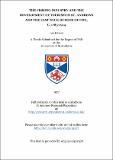The fishing industry and the development of tourism in St. Andrews and the East Neuk Burghs of Fife, c. 1785-1914
Abstract
The thesis traces the development, between 1790 and 1914, of the two industries of fishing and tourism, which, by the end of the 19th century, dominated the economies of the Fife coastal burghs, stretching from St. Andrews to Earlsferry. Both industries expanded enormously throughout Scotland during the 19th century. Scotland's fisheries were long-established, but their prosperity after 1808 was based upon the rapid growth of the Scottish cured herring trade; the tourist industry, on the other hand, was a new area of economic activity, which developed with the ability of ever-increasing number of people to afford a holiday by the seaside. The East Neuk burghs had the potential for expansion in both industries. For centuries, fishing has been an important occupation in the area, and the re-appearance of large shoals of herrings in local fishing grounds, particularly in the period 1840-1865, was the impetus required to stimulate the growth of a flourishing local curing industry. Equally, with their beaches, sea-bathing facilities, golf links and picturesque surroundings, the burghs were equipped, to varying degrees, to attract holiday visitors, particularly since the extension of the railway system made the East Neuk readily accessible to the population of the nearby large urban centres of Central Scotland. The two Industries were not incompatible - Anstruther had both a prosperous fishing community and numerous summer visitors by 1914. Compatibility was largely dependant upon the character of the resort. In St. Andrews and Elie, tourism had developed early, with an emphasis upon 'gentility' and peaceful repose; the simultaneous development of a large scale fishing industry was subsequently considered inconceivable. Thus, the major fishing ports such as Anstruther, did not become size- able resorts until the close of the 19th century, when less affluent sectors of the population who were less fastidious in the facilities and lenities which they demanded were able to afford seaside holidays. Accommodation for summer visitors in Pittenweea, St, Monance and Anstruther, had not been available in the mid 19th century when the area had been one of Scotland's premier fishing districts; housing accommodation did not expand quickly enough to supply the demands of the rapidly increasing local population. The decline of the local fisheries after 1870 promoted a rationalisation of the fishing industry. Larger and better boats were invested in, and though the fleet remained "based upon the East Neuk, catches were made and landed in other districts in Scotland, England, and Ireland. However, even the need for increased capital outlay, particularly with the development of steam fishing boats, did not cause successful large fishing companies to become established, and in 1914, as in 1790, the fishing community was still a close knit, independent and distinctive feature of the East Neuk fishing ports.
Type
Thesis, PhD Doctor of Philosophy
Collections
Items in the St Andrews Research Repository are protected by copyright, with all rights reserved, unless otherwise indicated.

